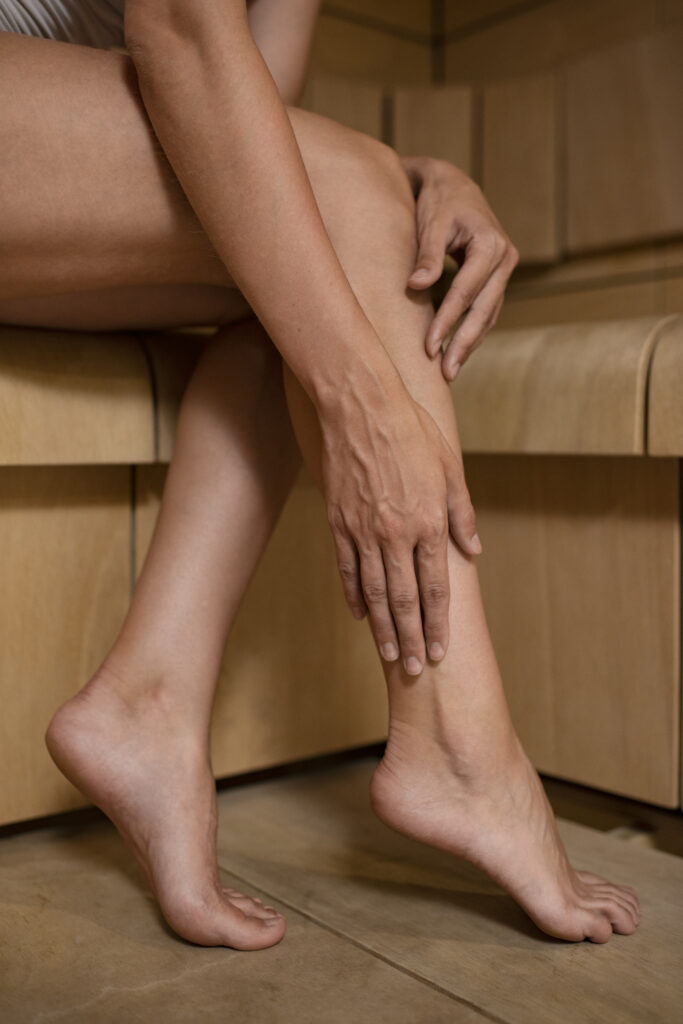

Varicose veins are a very common condition, affecting up to three in 10 adults. Usually, women tend to be more affected than men. Prevalence data vary, but it is thought they are found in around 10–20% of men, and 25–33% of women. Any vein in the body can become varicose, but they most commonly develop in the legs and feet. They tend to develop on the back of the calf or on the inside of the leg. This is because standing and walking puts extra pressure on the veins in the lower body.
For most people, varicose veins do not present a serious health problem and are mainly a cosmetic concern. They may have an unpleasant appearance, but generally do not affect the circulation or cause any long-term health problems. Most varicose veins do not require any treatment.
Some people with varicose veins do not experience any pain or discomfort, while others are more severely affected. As well as their distinctive appearance, symptoms of varicose veins can include:
These symptoms will usually be worse during warm weather or when standing up for long periods of time. Symptoms may improve with walking around or rest with elevated legs, on some pillows (for example).
There are a number of risk factors that can increase the likelihood of developing varicose veins, including:
These risk factors are discussed in more detail below.
Women are more likely to be affected by varicose veins than men. Research suggests that this may be because female hormones tend to relax the walls of veins, making the valves more prone to leaking.
The risk of developing varicose veins is increased if a close family member has the condition.
As part of the ageing process, veins start to lose their elasticity and the valves inside them stop working as well.
Being severely overweight puts extra pressure on veins, which means they have to work harder to send the blood back to your heart. This can put increased pressure on the valves, making them more prone to leaking.
Some research suggests that jobs that require long periods of standing may increase the risk of getting varicose veins. This is because blood does not flow as easily when standing for long periods of time.
When a woman is pregnant, the amount of blood in her body increases to help support the developing baby. This puts extra strain on the circulatory system. Increased hormone levels during pregnancy also cause the muscular walls of the blood vessels to relax. Both of these factors may increase the risk of developing varicose veins. Varicose veins may also develop during pregnancy as the uterus begins to grow. As the womb expands it puts pressure on the veins in the pelvic area, which can sometimes cause them to become varicose. Although being pregnant can increase the risk of developing varicose veins, most women find that the condition significantly improves after their pregnancy.
Discomfort after prolonged standing, relief with leg elevation or wearing compression stockings, and discomfort over the varicose veins suggests that the symptoms are due to varicose veins. In addition, a duplex ultrasound scan which uses high-frequency sound waves to produce a picture can show the blood flow and identify any damaged valves that might be causing the varicose veins.
If a patient presents to pharmacy asking for advice about varicose veins, it’s important to check if the varicose veins are bleeding. If this is the case, offer first aid and refer patient to their GP. If varicose veins are not bleeding, offer information and advice on compression hosiery which provide graduated pressure from the distal to proximal portion of the leg and increase venous blood flow by improving the action of the calf-muscle pump. Compression hosiery vary in degree of compression (class), length (below knee or thigh length), colour, and whether they enclose the whole foot or stop just before the toes (closed or open toe).
Secondary care interventional treatments can be done under local or general anaesthesia and may include:
Varicose veins may become more severe over time and can lead to complications such as skin damage (eczema and pigmentation changes), bleeding and venous ulceration. It is not known which people will develop more severe disease, but it is estimated that 3–6% of people who have varicose veins in their lifetime will develop venous ulcers.
Offer lifestyle advice:
Advise the patient to seek further medical help if in the future:
Unknown

Share This Page